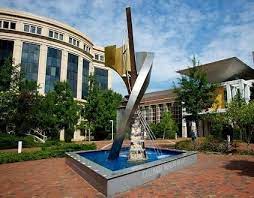 The Columbia Museum of Art (CMOA) is an art museum located at 1515 Main St, Columbia, SC 29201. The original building opened to the public on June 5, 2015. The CMOA was designed by London-based architecture firm Herzog & de Meuron. It's the first contemporary art museum and home to the 40-year-
The Columbia Museum of Art (CMOA) is an art museum located at 1515 Main St, Columbia, SC 29201. The original building opened to the public on June 5, 2015. The CMOA was designed by London-based architecture firm Herzog & de Meuron. It's the first contemporary art museum and home to the 40-year-
The CMOA has an impressive art collection that includes a wide array of mediums, themes and styles. Many of the pieces in the collection are also recent acquisitions. Highlights include a collection of works by Jeff Koons, a sculpture of a pink bunny by Louise Bourgeois and a large-scale installation of The Flower Crown, a piece by Jenny Holzer. The open spaces in the building have been designed to encourage visitors to explore the art, allowing for the creation of new connections and relationships between the pieces. The museum also features a space for a program of live art, which is integrated with the regular exhibitions.
The museum is the first of its kind in the state of South Carolina and is meant to encourage and promote the appreciation of art in the region. The museum is also an opportunity for the community to explore the wide variety of contemporary art available. Some of the pieces are from private collections and have never been displayed outside of their original homes. The CMOA is based on the belief that art is meant to be experienced, not simply looked at.
The new building for the CMOA was designed by the Swiss architectural firm Herzog & de Meuron. The architects collaborated with New York City-based art adviser Felix Gonzalez-Torres on the selection of the works for the museum. The building’s concrete facade is marked by irregular ribbing, which is intended to evoke the texture of bricks and mortar. The horizontal lines create a grid that defines the building’s plan, and the irregular ribbing echoes Herzog & de Meuron’s series of blue rectangles that grace the facade of the existing building. The glass panels that cover the new building’s facade are meant to evoke the forms of waves breaking against the shore, an allusion that is reinforced by the building’s placement on the edge of a lake.
The new CMOA building draws upon the history of the region. The building’s grid pattern also recalls the long, narrow buildings that once dotted the landscape of the state. The irregular ribbing on the facade is also intended to evoke the texture of bricks and mortar, a reference to the region’s history as the home of the slave culture. The building’s placement on the edge of a lake—a site that once hosted slave auctions—also recalls the role that rivers have played in the history of the state. The building’s transparent facade and use of glass—which evokes waves crashing against the shore—are also allusions to the region’s maritime history.
The CMOA also features an extensive selection of works by contemporary artists. Some of the pieces in the collection have been on view at other museums, while others have never been exhibited outside of private homes or private collections. The museum also has a program of live art that is integrated with the regular exhibitions.
The new Columbia Museum of Art is one of the most impressive contemporary art museums in the country. The museum is dedicated to the display and appreciation of contemporary art and is home to an impressive collection of works by prominent artists. The building is also marked by irregular ribbing and blue rectangles that reference the region’s history as the home of the slave culture. The museum’s extensive program of live art and its integration of art and architecture make it one of the most unique and impressive contemporary art museums in the country.
Driving Directions To Ballentine Storage From Columbia Museum of Art
Driving Directions To Lexington County Museum